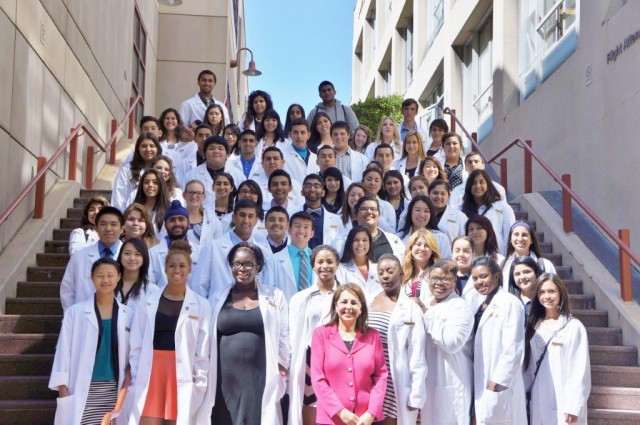Three high schools in Fresno County now have a Doctors Academy, a rigorous health education program aimed at under-represented students. It started at Sunnyside High School in 1999, then Caruthers and Selma high schools in 2007. This year, 81 students graduated from the three schools.
Students Benefit From Rigorous Academic Foundation
Students attend Doctors Academy classes every day. First and foremost, they learn the tools of studying. It pays off. So far, 100 percent of the students who stick with the program have graduated and 99 percent later attend four-year colleges. The attrition rate is about 10 percent, and those students continue to be tracked by the program.
This year, Huerta will graduate from UC-Santa Cruz with a degree in human biology and a minor in Latin American Studies. She said she wants to become a physician assistant. Her fiancé and the father of her child, Angel Álvarez, another Doctors Academy and UC-Santa Cruz student, plans to get a masters degree in school counseling at Fresno State.
Lots of people have helped them along, Huerta said, but the founder and director of the Doctors Academy -- Katherine Flores -- really paved the way. Flores also grew up in a farmworker family, raised by her grandparents. She graduated from Stanford and went to medical school at UC-Davis.
"Having been a farmworker myself and having gone to college and having struggled initially, I was acutely aware of the need to have a better academic foundation," Flores said. "You can have a dream but if you don't have the tools to attain that dream, you're really stymied."
It wasn't that her grandparents weren't interested, she said. They just didn't know. "That story hasn't changed for a lot of our immigrant families who come to the country looking for better opportunities but don't know how to navigate that. It's the genesis of why we developed the program."
Lack of Health Providers in the Valley Inspires Program
Flores came up with idea for the Doctors Academy while she was doing her residency at UCSF Fresno -- the UC-San Francisco medical education program at Fresno's Community Regional Medical Center. The rationale for the project was to increase the number of health providers in the Central Valley and to increase the diversity of providers to match the population of the valley.
"Looking at the demographics, looking at how best to do that, we thought about a pipeline," said Flores, who partnered with and receives funding from UCSF Fresno. The program also relies heavily on grants and collaborates with city and county school districts.
[contextly_auto_sidebar id="1ThWjMKEQS4kcIrKvEP6nMA7XCpP7fji"]
After a few years, organizers determined that kids needed intervention even earlier than high school; there are now three Junior Doctors Academies at middle schools that feed into Sunnyside. Caruthers will start one in the fall, and Selma hopes to develop one. There's also a college program at Fresno State.
The academy focuses on cultural competency and health disparities, as well as leadership building. Students are required to do volunteer work -- known as "service learning" -- within the community.
"Helping a community be healthy also means not sitting back and watching things happen," said Flores.
And there's plenty of clinical exposure. Students spend six weeks of the summer before their junior year at a hospital rotating through different departments. "Kids get to really see how a hospital system works, the different jobs that are there," Flores said.
The summer before their senior year, students do a six-week clinical internship. They also put in 80 hours of research and write and present a paper on a particular health problem with the lens on disparity. The program stays in touch with students after they graduate: via quarterly email; job and internship possibilities; help with applications to health professional schools. And long before they go to college, there are parent workshops on financial aid.
Students Return to the Valley
Tia Vang was in the first class of the Doctors Academy at Sunnyside. The program helped her see health disparities in her own Hmong community. In fact, a few years after she graduated from UC-Berkeley double majoring in biology and ethnic studies, she volunteered at Stone Soup, a not-for-profit that works primarily with Southeast Asian refugees in Fresno. One of her projects was to look into how language affected access to health care, and she found there were a lot of unmet needs especially for new Hmong refugees and for the elderly.
This fall, Vang plans to attend medical school at the University of Washington.
"There are not a lot of Hmong physicians in Fresno," Vang said. "I feel obligated to come back and do something and address health disparity in my community and to collaborate with other ethnic backgrounds."
It's too early to tell what percentage of kids from the Doctors Academy will stay in and around Fresno. But several kids who chose careers that don't require the time commitment of medical school are already working in the area at the county health department, in social services, as nurses or science teachers. There are even a few lawyers.
Nathan Singh, also a graduate of the first class at Sunnyside, said he exemplifies the goals of the program. When he was six, his dad, a taxi driver, was murdered. A passenger shot him eight times. His mom worked hard to raise him and his siblings but they had little money. He says the academy gave him an anchor, a strong purpose during his adolescence. He became passionate about medicine after volunteering at Community Medical Center. This fall, he'll start a residency in family and community medicine in San Diego. He can see himself eventually returning home and he believes in the academy's mission.
